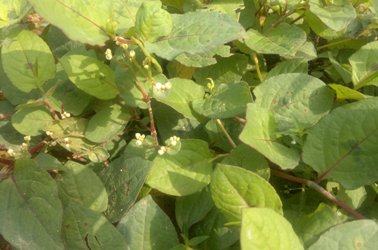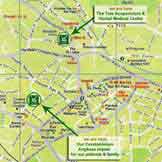|
Neuro Acupuncture and Ancestral Formula Chinese Herbal Medicine |
|
|
|
|
|
| |
|
|
| |
|
|
| |
|
|
|
 |
WHAT IS DIABETES INSIPIDUS ? |
Diabetes/Diabetic - The syndrome is caused by heposecretion of antidiuretic hormone resulting from hypothalamus-pituitary lesion. Diabetes/Diabetic can also be secondary to other diseases. The state of illness may be mild or severe, transient or permanent.
|
|
CLINICAL DIABETES DIAGNOSIS |
1.Diabetes/Diabetic- Polyuria, polydipsia and increased water intake are the principle features. If water intake is restricted, severe dehydration may occur.
2. The etiology of primary Diabetes/Diabetic insipidus remains indeterminate. Secondary cases may be initiated by tumor, infection or trauma of the hypothalamus-pituitary system or the adjacent tissues.
3. Diabetes/Diabetic -Accessory examination
a) The specific gravity of urine is reduced and usually less than 1.006. The osmotic prnsipidus from psychogenic polydipsia and polyuria.
b) The osmotic pressure of plasma is elevated. There may appear dizziness, dysphoria, tachycardia or disorder of consciousness, the so-called hyperosmotic syndrome.
c) Water-deprivation test and hypertonic saline test are used to distinguish diabetes insipidus from psychogenic polydipsia and polyuria. Water- deprivation test is dangerous, and now is rarely performed.
| TYPES OF DIABETES SYNDROMES and DIANOGSIS |
Deficiency of the Kidney-Q. Main Symptoms: Polydipsia, frequent and profuse urination, emaciation, aching pain in the lumbus, lassitude. The case exhibiting more symptoms and signs of deficiency of the kidney-yin Diabetes is marked as feverish sensation in the palms and soles, restlessness, red tongue with little fur, deep, thread and rapid pulse; while the case presenting more symptoms and signs of deficiency of the kidney-yang is manifested as light colour urine, aversion to cold, impotence, pale tongue with whitish fur, and deep, thread and weak pulse.
|
| |
WHAT IS DIABETES MELLITUS? |
Diabetes Mellitus is a common metabolic endocrinopathy resulting from absolute or relative deficiency of insuline and leading to metabolic disturbance of carbohydrate, fat and protein. The Diabetes disease is frequently followed by water-electrolyte imbalance and acid-base disturbance. According to the age of the patients, clinical manifestations and requirements for insulin, diabetes can be divided into many types.
|
| |
DIABETES/DIABETIC CLINICAL DIAGNOSIS |
1. The characteristics of a typical case of diabetes/diabetic mellitus are often polyphagia, polydipsia, polyuria and loss of body weight. Early or asymptomatic patients only show abnormal release of cortical hormone and insuline inside the body. The level of fasting blood sugar is elevated with abnormal glucose tolerance test. Symptomatic patients are frequently complicated by other symptoms of dermal, neural and endocrinous disorders, besides polyphogia, polyuria and loss of body weight.
2. The main complications and concomitant diseases of diabetes mellitus are diabetic ketoacidosis, cardiovascular diseases, diabetic renopathy and peripheral neuropathy. Cardiovascular complications are the chief causes of death.
3. Diabetes mellitus is classified into juvenile and adult types according to the clinical features. The age of onset of the juvenile type is young and has a tendency to inherit. Blood sugar fluctuates widely and is quite sensitive to insulin. Diabetes/Diabetic Treatment is difficult and it is often named insulin-depending diabetes/diebetic or unstable diabetes/diebetic. The age of onset of adult type is above 40. This type is relatively mild and can be controlled by dietary restriction or oral antidiabetics. Therefore it is also named non- insulin depending diabetes/diebetic or stable diabetes/diebetic.
4. Accessory examination
a) Fasting blood-glucose is higher than 130 mg. Blood glucose after meal is more than 160-180 mg. Urine is positive for glucose. If complicated by ketosis, urine is positive for ketone bodies.
b) Glucose tolerance test can be used to diagnose early or suspected cases and is the principle test in diagnosis.
c) New diagnostic techniques such as testing blood insuline levels are quite helpful in understanding the pathological changes of pancreas and in obtaining information concerning treatment.
|
| |
TYPES OF DIABETES SYNDROMES |
1.Diabetes/diebetic Heaty Conditions - Dryness-heat in the Lung and Stomach Main Symptoms : Restlessness, polydipsia, polyphagia with tendency to hunger, dryness of the mouth and tongue, polyuria, red tongue with yellowish fur, slippery and rapid pulse.
2. Deficiency of the Kidney Main Symptoms : Polyuria with turbid discharge, soreness and debility of the lumbus, dryness of the mouth and tongue, dyshopria with feverish sensation in the chest, palms and soles, red tongue, deep, thready and rapid pulse.
|
| |
Hypoglycaemia (low blood glucose) in diabetes/diabetic patients |
Hypoglycaemia or low blood glucose is a condition where the level of glucose (sugar) in the blood drops below a certain point (about 3.0mmol/l). This causes a number of symptoms that usually go away 10 to 15 minutes after eating sugar.
Regular blood sugar tests can help you identify when you need to pay extra attention to your blood sugar level.
Causes
of Diabetes/Diabetic
Insulin is normally produced in the pancreas and helps the body's cells absorb glucose from the blood. Normally, the glucose level rises after a meal to about 7 to 10mmol/l and insulin is secreted from the pancreas. The glucose level starts dropping again about one to two hours after the meal, and is back to normal by the next meal (about 4 to 5.5 mmol/l). By this time, the insulin level in the blood has also returned to normal.
Diabetes/Diabetic patients, hypoglycaemic episodes (also known as 'hypos') can be caused by too much insulin in the blood, or less insulin is needed.
Too much insulin in the blood
The dose of insulin or antidiabetic tablets is set too high.
The patient has accidentally overdosed or been given too many tablets.
Less insulin needed
1.If the patient has eaten less than usual.
2.If there has been physical activity.
If the patient has been drinking alcohol.
|
| |
What happens during a hypoglycaemic episode? |
Hypoglycaemia can cause some or all of the following symptoms:
- paleness
- shaking
- perspiration
- a feeling of weakness
- rapid heartbeat
- hunger
- agitation
- difficulty concentrating
- irritability
- fatigue
- blurred vision
- temporary loss of consciousness
- confusion
- convulsions
- coma
Hypoglycaemia does not cause any of the above symptoms in some Diabetes/Diabetic patients. This is especially the case where long-standing Diabetes/Diabetic is concerned. In these patients, convulsions and loss of consciousness can occur without warning. To avoid this, they are asked to maintain a higher level of glucose in the blood and to measure it more frequently than is normally required. This is very important.
Diabetes/Diabetic - Hypoglycaemic episodes can be categorised as:
1. Mild hypoglycaemia or hypoglycaemic episodes. The patient can manage these episodes alone.
2. Serious hypoglycaemia. The patient will need help from others, either a family member or a doctor. |
| |
Blood glucose levels |
Blood glucose level is the amount of glucose (sugar) in the blood. It is also known as serum glucose level. The amount of glucose in the blood is expressed as millimoles per litre (mmol/l).
Blood glucose levels stay within narrow limits throughout the day (4 to 8mmol/l). But they are higher after food and usually lowest in the morning or when you are hungry.
When a person has Diabetes/Diabetic , their blood glucose level usually moves outside these limits.
Controlling blood glucose levels:
Diabetes/Diabetic patients should always try to keep your glucose level as near normal as possible.
Stable blood glucose significantly reduces the risk of developing late-stage diabetic complications. These may start to appear 10 to 15 years after diagnosis with Type 1 Diabetes/Diabetic and often less than 10 years after diagnosis with Type 2 Diabetes/Diabetic .
Complications:
- Neuropathy (nerve disease)
- Retinopathy (eye disease)
- Nephropathy (kidney disease)
- Cerebrovascular disease, such as stroke
- Cardiovascular disease, such as heart attack, hypertension and heart failure.
- Gangerene
|
| |
The best readings are: |
4 to 7mmol/l before meals.
less than 10mmol/l one-and-a-half hours after meals.
around 8mmol/l at bedtime. |
| |
Please feel free to contact or email us for further details at : |
THE TOLE ACUPUNCTURE & HERBAL MEDICAL CENTRE SDN BHD.
Lot 2.01, 2nd Floor,
Medical Specialist Floor,
Menara KH (Menara Promet),
Jalan Sultan Ismail, 50250 Kuala Lumpur.
Malaysia
Tel No : +603-21418370 / +603-21451671
Whatsapp (only): +6012-7688284
Acupuncture Time : |
| Operating Hours : |
| Monday : 10AM - 6PM |
| Tuesday : 1PM - 7PM |
| Wednesday to Saturday : 10AM - 7PM |
| Sunday : 12PM - 4PM |
| *(Malaysia Time) |
| |

|
|
|
|
|
 |
Easiest way to reach us, click below! |
|
|
| |
We can send herbs to your home by: |
|
|
| |
We accept the following payment options in our centre. For Online Payment, please use Direct Transfer. |
|
|
| |
The Tole's Opening Ceremony |
Our New Acupuncture Centre was officially open by our Health Minister YAB Dato' Lee Kim Sai on 31st January 1993. |
YAB Dato' Lee Kim Sai and Dato' Leong Hong Tole (D.S.T.M) - [World Known as MasterTole] |
|
|
|
| |
| |
Share us with your friends. |
They may need our assistance! |

LIKE OUR FACEBOOK PAGE! |
| |

FOLLOW OUR TIKTOK PAGE! |
| |

FOLLOW OUR INSTAGRAM PAGE! |
| |
|
| |
The Star News |
|
|
The Star Newspaper report on Our Master's Acupuncture and Herbal TCM on 5th February 2011, Saturday. |
|
|
| |
|
|
 The Tole Officially Opened by our Health Minister. The Tole Officially Opened by our Health Minister.
- Acupuncture Centre
|
|
|
| |
|
Contact Us
Neuro Acupuncture and Herbal Medicine |
THE TOLE
ACUPUNCTURE-HERBAL MEDICAL CENTRE SDN BHD
Lot 2.01, 2nd Floor, Medical Specialist Floor, Menara KH (Menara Promet), Jalan Sultan Ismail, 50250 Kuala Lumpur
Tel: +603-21418370
+603-21451671
Whatsapp (only): +6012-7688284
| Acupuncture Time : |
Operating Hours : |
Mon : 10AM - 6PM |
Tue : 1PM - 7PM |
Wed to Sat : 10AM - 7PM |
Sun : 12PM - 4PM |
*(Malaysia Time) |
| |
* E-mail consultation with Master and Assistant.
Ask by e-mail

|
|
|
| |
Accommodation
Neuro Acupuncture and Herbal Medicine |
|
CONDOMINIUM |
|
| |
|
|
| |
|
| |
|
| |
Easiest way to reach us, click below! |
|
|
| |
|
|